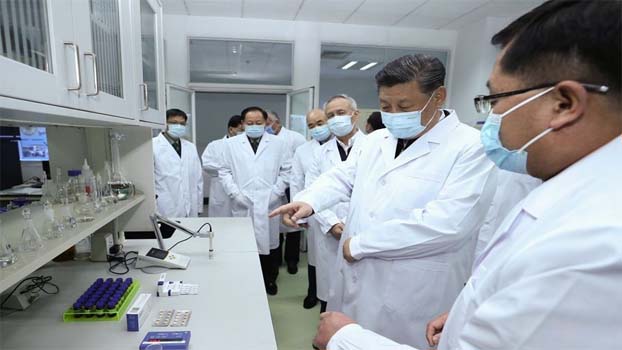Victory in sight for the Chinese people led by Xi Jinping in their war on COVID-19


China’s anti-COVID-19 fight, led by its top leader, is inching closer to victory just over a month after the epidemic broke out, thanks to the concerted efforts made by society as a whole.
Note: The following article is taken from the Chinese-language opinion column "The Real Point."
“This novel coronavirus epidemic has been the fastest spreading, with the most infected, and has been the most difficult to prevent and control since the founding of the People’s Republic. This is a crisis for us, and it is also a major test.” The words of President Xi Jinping as he held a recent teleconference involving more than 170,000 public servants.
China, caught off guard by the COVID-19 outbreak during the Spring Festival, usually sees 1.2 of its 1.4 billion people travel during the annual family reunion holiday. But the entire nation came to a pause during this year’s festive season, following the call made by the president, to stay at home, to minimize outdoor activities and avoid mass gatherings, and to wear face masks if going out. People have been working together with government agencies for epidemic prevention and control.
Over the 40 days between January 25 and March 4, Xi Jinping presided over six meetings of the Standing Committee of the Political Bureau of the Communist Party of China (CPC) to analyze and study the prevention and control of the epidemic. During this period, he also conducted two field inspections in Beijing to guide the epidemic prevention and control as well as scientific research work.
It is under the powerful and efficient command and deployment of China's top leader that the country has given full play to its institutional advantages of mobilizing resources to accomplish major tasks, adopted the most ambitious, agile and aggressive disease containment effort in history, and resolutely and vigorously fought the battle against the epidemic. It took China just over a month to turn around the difficult situation in epidemic prevention and control with fruitful results thanks to the efforts of 40,000 medical workers from around the country dispatched to join the local staff in Hubei Province, the center of the outbreak, to combat the disease, building epidemic prevention and control networks covering rural and urban areas, building new hospitals to house as many infected patients as possible, and various industries working day and night to ensure important medical supplies.
The progress China has made in epidemic prevention and control is encouraging amid a severe situation around the world. As of Friday, a total of 55,404 confirmed patients had been cured and discharged from the hospital on the Chinese mainland, accounting for 68 percent of all the confirmed cases. The number of newly confirmed cases on the Chinese mainland has been decreasing steadily, dropping to below 100 (including 24 imported cases) for the first time on Friday.
On Thursday, World Health Organization Director General Tedros Adhanom Ghebreyesus said at a press conference held in Geneva that in Beijing he saw China's approach, led by President Xi, to mobilize the whole government and society and make the response every citizen’s business. He highlighted “If the highest level of government, the head of state or head of government, starts to lead and coordinate all sectors, that brings qualitative change in the way we respond to the epidemic.”
Many world-renowned medical experts have pointed out that China had played a significant role in protecting the global community and creating a stronger first line of defense as well as a window of opportunity to contain international spread. The Lancet published an editorial on Saturday, quoting a WHO-China joint mission report which calls China's measures toward the COVID-19 virus probably the most “ambitious, agile and aggressive disease containment effort in history.” The editorial said “China seems to have avoided a substantial number of cases and fatalities,” and that “China's success rests largely with a strong administrative system that it can mobilize in times of threat, combined with the ready agreement of the Chinese people to obey stringent public health procedures.”
As the footsteps of spring are getting closer, the unease Chinese people had when the outbreak first appeared over a month ago is turning into a firm confidence of victory over the epidemic. That day is not far ahead as conditions favorable for epidemic prevention and control continue to expand.

